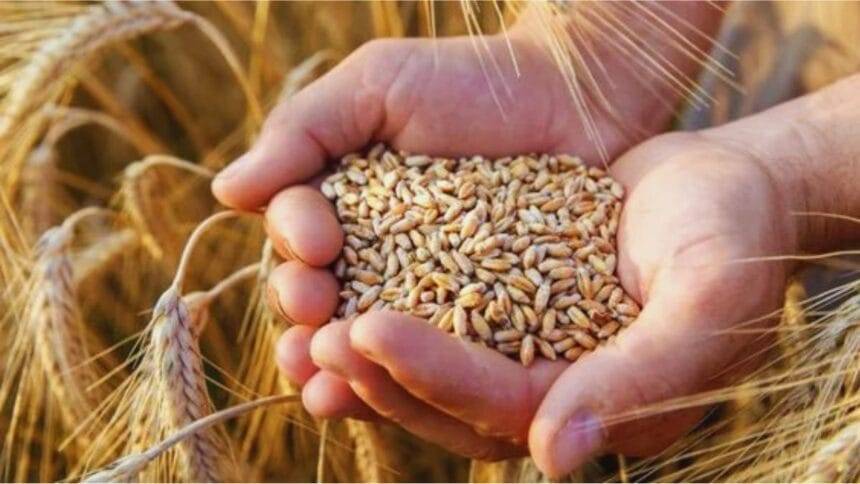Main Points In Hindi (मुख्य बातें – हिंदी में)
यहाँ दिए गए पाठ के मुख्य बिंदु निम्नलिखित हैं:
-
गेहूं की बुवाई का सही समय: नवंबर के महीने को रबी सीजन की मुख्य फसल गेहूं के लिए बुवाई का उचित समय माना गया है। किसानों को अच्छी किस्म के बीजों की पहले से व्यवस्था करने की सलाह दी गई है।
-
बीज और उर्वरक की आवश्यकता: प्रति हेक्टेयर गेहूं की अच्छी उपज के लिए 100 किलोग्राम बीज की आवश्यकता होती है। इसके साथ ही, नाइट्रोजन, फॉस्फोरस और पोटाश उर्वरकों की मात्रा क्रमशः 120, 50 और 40 किलोग्राम प्रति हेक्टेयर होनी चाहिए।
-
कृत्रिम कीटनाशक का उपयोग: जहाँ टर्माइट संक्रमण है, वहां प्रति हेक्टेयर 5 लीटर क्लोरपाइरिफॉस 20 ईसी का उपयोग करना चाहिए।
-
मूँगफली और सरसों की बुवाई: सरसों की बुवाई के लिए तापमान का ध्यान रखना आवश्यक है। उचित नमी सुनिश्चित करते हुए, सरसों की उन्नत किस्मों में पूसा विजय, पूसा सरसों-29, पूसा सरसों-30, आदि शामिल हैं।
- मटर की तैयारी: मटर की बुवाई में देरी से उपज कम हो सकती है। बीजों को फफूंदनाशक कैप्टन या थिरैम के साथ उपचारित किया जाना चाहिए और विशेष रूप से राइजोबियम टीके का उपयोग किया जाना चाहिए।
Main Points In English(मुख्य बातें – अंग्रेज़ी में)
Here are the main points regarding the sowing of early varieties of wheat, mustard, and peas, along with the associated agricultural practices:


-
Wheat Sowing Guidelines: Farmers are advised to prepare for the sowing of early varieties of wheat in November, ensuring they have good seed varieties ready. A recommended quantity of 100 kg of seeds per hectare must be arranged, along with required fertilizers (120 kg nitrogen, 50 kg phosphorus, and 40 kg potash per hectare).
-
Pest Management for Wheat: Farmers dealing with termite infestations should apply Chlorpyrifos 20 EC at the rate of 5 liters per hectare along with Paleva to manage such issues effectively.
-
Selection of Wheat Varieties: Notable high-yielding wheat varieties include HD 3385, DBW 370, and others, with potential yields of 80-100 quintals per hectare based on proper planting timing and conditions.
-
Mustard Sowing Considerations: Mustard should also be sown without delay, with an emphasis on checking soil moisture and ensuring proper treatment of seeds with fungicides and sulfur if deficiencies are noted. Improved varieties like Pusa Vijay and Pusa Mustard require approximately 1.5-2 kg of seeds per acre.
- Moisture Monitoring for Peas: Similar attention must be paid to peas, where soil moisture is crucial for germination. Proper seed treatment with Captan or Thiram alongside a crop-specific Rhizobium vaccine is recommended before sowing improved varieties like Pusa Pragati.
Complete News In Hindi(पूरी खबर – हिंदी में)
गेहूं की शुरुआती किस्मों की बुवाई का समय आ गया है, जो रबी मौसम की मुख्य फसल है। नवंबर का महीना इसके लिए बहुत अनुकूल माना जाता है। इसलिए, वैज्ञानिकों ने सलाह दी है कि किसान पहले से अच्छे बीजों की व्यवस्था कर लें। अच्छी उपज के लिए प्रति हेक्टेयर 100 किलोग्राम बीज की आवश्यकता होती है। इस आधार पर, अपने खेतों के लिए समय पर बीज और खाद की व्यवस्था करें। मौसम का ध्यान रखते हुए, गेहूं की बुवाई के लिए खाली खेतों को तैयार करें। जिन खेतों में दीमक का संक्रमण है, वहां 5 लीटर क्लोरपाइरीफोस 20 EC व पालेवा के साथ प्रति हेक्टेयर दें। नाइट्रोजन, फास्फोरस और पोटाश की मात्रा प्रति हेक्टेयर 120 किलोग्राम, 50 किलोग्राम और 40 किलोग्राम होनी चाहिए।
गेहूं की शुरुआती किस्मों में मुख्य हैं: एचडी 3385, एचडी 3386, एचडी 3298, एचडी 2967, एचडी 3086, एचडी सीएसडब्ल्यू 18, डीबीडब्ल्यू 370, डीबीडब्ल्यू 371, डीबीडब्ल्यू 372 और डीबीडब्ल्यू 327। एचडी 3385 एक उच्च उपज देने वाली किस्म है। यदि इसे सही समय पर बोया जाए तो यह प्रति हेक्टेयर 80-100 क्यूंटल तक उपज देती है। यह किस्म उत्तर-पश्चिमी और उत्तर-पूर्वी मैदानों के खेतों के लिए उपयुक्त मानी जाती है। डीबीडब्ल्यू 370 की उत्पादन क्षमता प्रति हेक्टेयर 86.9 क्यूंटल है। इस किस्म में प्रोटीन का मात्रा 12 प्रतिशत, जिंक 37.8 पीपीएम और आयरन 37.9 पीपीएम होता है।
ये भी पढ़ें: चने की खेती, खेतों के लिए ‘खाद कारखाना’, bumper yield के लिए कितनी दूरी और गहराई पर बोना चाहिए?
सुधरी हुई सरसों की किस्में
तापमान को ध्यान में रखते हुए, किसानों को सरसों की बुवाई में और देरी नहीं करनी चाहिए। यदि मिट्टी परीक्षण के बाद सल्फर की कमी है, तो आखिरी जुताई में प्रति हेक्टेयर 20 किलोग्राम इसकी मात्रा डालें। बुवाई से पहले, मिट्टी में उचित नमी का ध्यान रखें। सरसों की सुधरी हुई किस्में हैं – पूसा विजय, पूसा सरसों-29, पूसा सरसों-30, पूसा सरसों-31 और पूसा सरसों-32। प्रति एकड़ 1.5-2 किलोग्राम बीज की आवश्यकता होगी।
बुवाई से पहले, खेत में नमी स्तर की जांच करनी चाहिए ताकि अंकुरण पर असर न पड़े। बुवाई से पहले बीजों को कैप्टन @ 2.5 ग्राम प्रति किलो बीज के हिसाब से उपचारित करें। पंक्तियों में बुवाई करना अधिक लाभकारी है। कम फैलने वाली किस्मों को 30 सेंटीमीटर की दूरी पर और अधिक फैलने वाली किस्मों को 45-50 सेंटीमीटर की दूरी पर बोएं। पौधों के बीच की दूरी को 12-15 सेंटीमीटर तक थिनिंग के द्वारा कम किया जाना चाहिए।
बुवाई से पहले नमी का ध्यान रखें
तापमान को देखते हुए, मटर की बुवाई में और देर न करें, अन्यथा फसल की उपज में कमी आएगी। कटाई में देरी की वजह से कीड़ों का संक्रमण बढ़ सकता है। बुवाई से पहले, मिट्टी में उचित नमी सुनिश्चित करें। सुधरी हुई किस्में हैं – पूसा प्रगति और आर्चिल। बीजों को फंगिसाइड कैप्टन या थिराम @ 2.0 ग्राम प्रति किलो बीज के हिसाब से मिलाकर उपचारित करें। इसके बाद, फसल के अनुसार राइजोबियम वैक्सीन लगानी होगी। गुड़ को पानी में उबालें, ठंडा करें, राइजोबियम को बीजों के साथ मिलाएं, उपचारित करें और फिर से सूखने के लिए छायादार जगह पर रखें और अगले दिन बुवाई करें।
ये भी पढ़ें: अफ्लाटॉक्सिन क्या है, इसे मक्का में कैसे नियंत्रित किया जा सकता है, इन टिप्स का पालन करें।
Complete News In English(पूरी खबर – अंग्रेज़ी में)
The time has come for sowing of early varieties of wheat, the main crop of Rabi season. The month of November is considered very suitable for this. Therefore, scientists have advised that farmers should arrange for good varieties of seeds in advance. For good yield, 100 kg seeds are required per hectare. On this basis, arrange for seeds and fertilizers for your farming in time. Keeping the weather in mind, prepare vacant fields for sowing wheat. In fields where there is termite infestation, give Chlorpyrifos 20 EC at the rate of 5 liters per hectare along with Paleva. The quantity of nitrogen, phosphorus and potash fertilizers should be 120, 50 and 40 kg per hectare.
Talking about early varieties of wheat, the main ones are HD 3385, HD 3386, HD 3298, HD 2967, HD 3086, HD CSW 18, DBW 370, DBW 371, DBW 372 and DBW 327. HD 3385 is a high yielding variety. If it is sown on time, it gives a yield of up to 80-100 quintals per hectare. This variety of wheat is considered suitable for the fields of north-western and north-eastern plains. The production capacity of DBW 370 is up to 86.9 quintals per hectare. The protein content of this variety is 12 percent, zinc is 37.8 ppm and iron is 37.9 ppm.
Read this also: Gram cultivation is a ‘manure factory’ for the fields, at what distance and depth should one sow for bumper yield?
Improved varieties of mustard
Keeping the temperature in mind, farmers should not delay further in sowing mustard. If there is sulfur deficiency after soil testing, then apply it at the rate of 20 kg per hectare at the last plowing. Before sowing, take care of proper moisture in the soil. The improved varieties of mustard are – Pusa Vijay, Pusa Mustard-29, Pusa Mustard-30, Pusa Mustard-31 and Pusa Mustard-32. 1.5-2 kg seeds will be required per acre.
Before sowing, check the moisture level in the field so that germination is not affected. Before sowing, treat the seeds with Captan @ 2.5 grams per kilogram of seeds. Sowing in rows is more beneficial. Sow less spreading varieties at a distance of 30 cm and sow more spreading varieties in rows made at a distance of 45-50 cm. Through thinning, plant to plant distance should be reduced to 12-15 cm.
Take care of moisture before sowing
Keeping the temperature in mind, do not delay sowing of peas further, otherwise the yield of the crop will reduce. Delay in harvest can lead to increased infestation of insects. Before sowing, ensure proper moisture in the soil. The improved varieties are -Pusa Pragati and Archil. Treat the seeds by mixing fungicide Captan or Thiram @ 2.0 grams per kilogram of seeds. After that, crop specific Rhizobium vaccine must be applied. Boil the jaggery in water, cool it, mix rhizobium with seeds, treat it and keep it in a shady place to dry and sow it the next day.
Also read: What is aflatoxin, how can this ‘poison’ be controlled in maize, follow these tips






